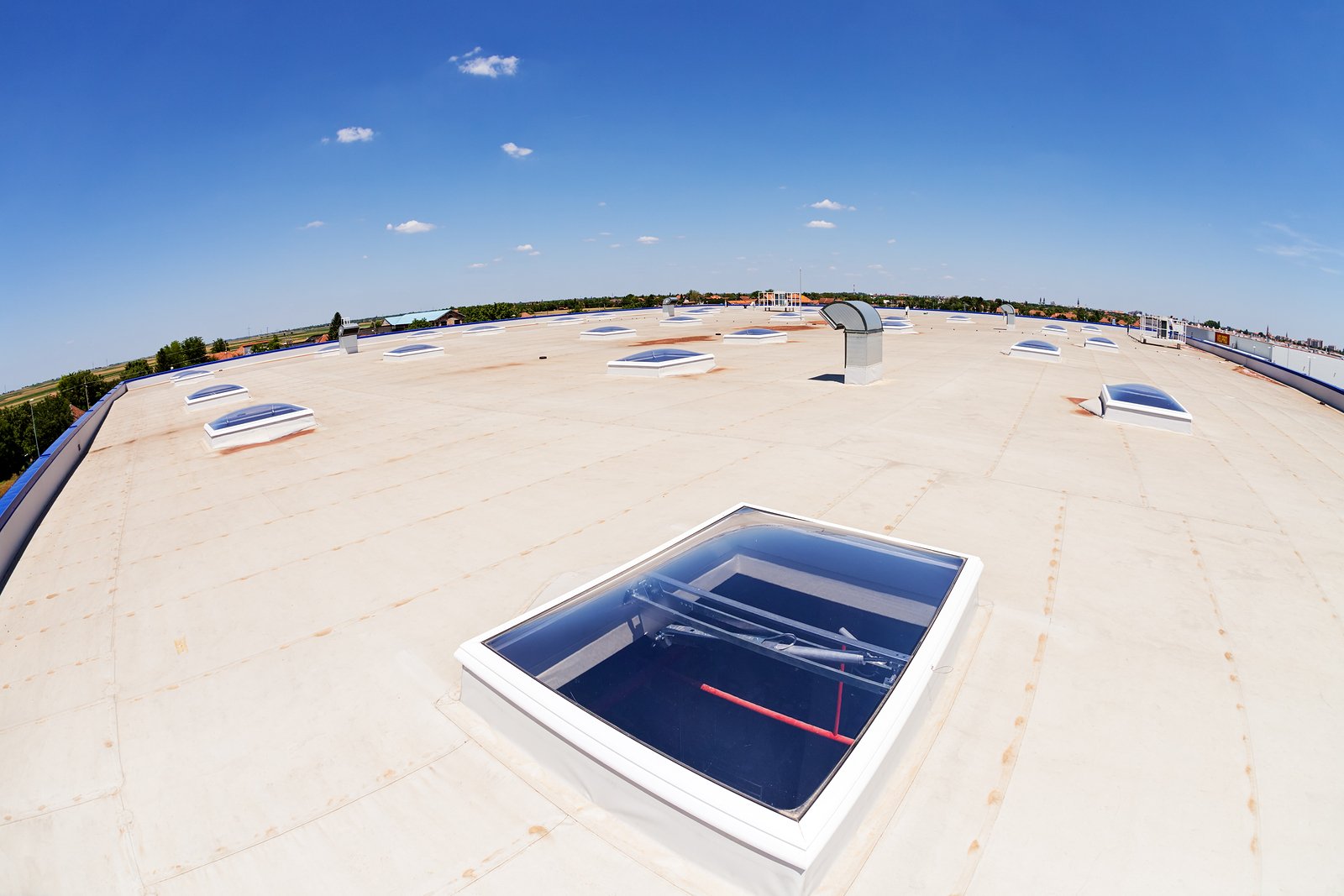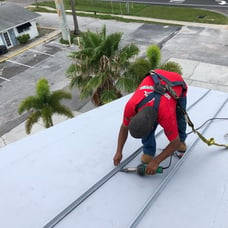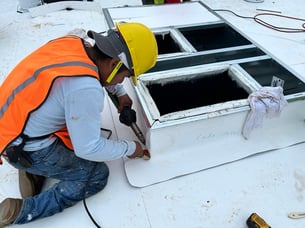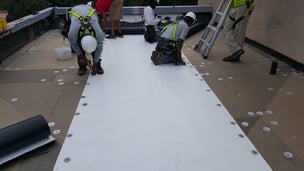
Sorting out different roofing types isn't for the faint of heart! So many options and variations- where do you start? As a business owner, making the right decisions to benefit your building is essential. Single-ply roofing is a popular choice for commercial and industrial buildings, and for good reason. This roofing type offers several advantages that make it a practical and cost-effective option.
At RoofCrafters, we've installed roofing systems for nearly thirty years. Whether you're looking at single-ply or another roof type, we've got you covered in the details so you can make an informed decision. No business owner wants to be left in the dark about their investments. Allow us to help guide you through your research!
This article discusses single-ply roofing, its benefits, and its drawbacks. Once you have a better idea of what to expect, you can brainstorm about your potential new roof. Time to officially get excited. Let's begin!
What is Single-Ply Roofing?
Single-ply is a type of roofing system known for its simplicity and efficiency. It's designed to be lightweight, durable, and easy to install. This roofing system is typically used on flat or low-slope roofs, which are common in commercial and industrial structures.
The "single-ply" part of the name refers to the fact that these roofing membranes consist of just one layer. This single layer serves as the primary waterproofing barrier for the building. Single-ply roofing membranes come in two primary types: thermoset and thermoplastic. Thermoset membranes are made from rubber polymers, while thermoplastic membranes are made from plastic polymers.

Both types of single-ply roofing membranes have their advantages. Thermoset membranes are highly durable and can withstand exposure to UV rays, ozone, and various weather conditions. On the other hand, thermoplastic membranes are known for their flexibility, making them more resistant to punctures and easy to install.
The installation process of single-ply roofing involves attaching the membrane to the roof deck using various methods like mechanical fastening, adhesive, or ballast. These membranes are often heat-welded at the seams, creating a watertight seal. Once in place, single-ply roofing systems provide excellent protection against water infiltration, making them ideal for low-slope roofs.
The Pros of Single-Ply Roofing
Single-ply roofing is a popular choice for commercial and industrial buildings, and for good reason. This roofing type offers several advantages that make it a practical and cost-effective option. Let's explore some of the key benefits of single-ply roofing.
Energy Efficiency: Single-ply roofing materials often come in reflective or white surfaces that can significantly reduce a building's cooling costs. These materials reflect sunlight, helping to maintain a more stable indoor temperature, which can result in energy savings.
Lightweight: Single-ply roofing is lightweight compared to many other roofing systems. This feature reduces the load on the building's structure, making it ideal for designs that can't support heavier roofing materials.
Installation Speed: Installing single-ply roofing is generally faster compared to other roofing systems. The sheets come in large rolls or sheets, which can be quickly and easily applied, reducing labor costs and minimizing disruption to building occupants.

Waterproofing: Single-ply roofing materials are excellent waterproofing agents. They create a seamless, watertight barrier over the roof that effectively prevents leaks and water damage.
Durability: These roofing materials are designed to withstand the elements and last for many years. They can resist UV radiation, ozone exposure, and extreme weather conditions, making them a long-lasting choice.
Versatility: Single-ply roofing systems are versatile and suitable for a variety of roof designs, including flat and low-slope roofs. They can be used in new construction or as part of a roof replacement project.

Ease of Maintenance: Maintaining single-ply roofing is relatively simple. Regular inspections and minor repairs can extend the roof's lifespan, ensuring it continues to perform effectively.
All in all, single-ply roofing offers several advantages, including energy efficiency, lightweight construction, fast installation, waterproofing capabilities, durability, versatility, and ease of maintenance. These benefits make it a practical and cost-effective roofing choice for many commercial and industrial buildings!
The Cons of Single-Ply Roofing
Can't have benefits without drawbacks, right? While single-ply roofing has its advantages, it's essential to consider its disadvantages as well. Let's delve into the cons of this roofing system.
1. Susceptibility to Punctures: Single-ply roofing materials, especially those made from thermoplastic membranes, are vulnerable to punctures from sharp objects or debris. If not addressed promptly, this can lead to leaks.
2. Limited Aesthetic Options: To maximize energy efficiency, single-ply roofing typically comes in white or reflective surfaces, which may not suit certain architectural styles or preferences.
3. Installation Challenges: While single-ply roofing is known for its quick installation, improper installation can lead to issues like seam separation or water infiltration. It's crucial to hire experienced professionals to ensure a proper installation.

4. Longevity Concerns: While single-ply roofing can have a long lifespan, its durability may not match that of some other roofing materials like metal or built-up roofing systems. Frequent exposure to harsh weather conditions can reduce its longevity.
5. Initial Cost: The cost of single-ply roofing materials and installation can be higher than some other roofing options, which may deter some budget-conscious property owners.
6. Vulnerability to Chemical Exposure: In certain industrial or chemical exposure environments, single-ply roofing materials may be susceptible to damage, requiring more frequent maintenance or replacement.
7. Environmental Impact: Some single-ply roofing materials, mainly PVC, are associated with environmental concerns due to their chlorine content and the potential release of toxic chemicals during manufacturing and fires.

As you can see, single-ply roofing has downsides, including susceptibility to punctures, limited aesthetic options, potential installation challenges, longevity concerns, initial cost, vulnerability to chemical exposure, and environmental impact. While these cons should be considered, they do not outweigh the benefits, making single-ply roofing a viable option for many commercial and industrial structures.
Is Single-Ply Roofing Right for Me?
Possibly! When picking out a new roof, the final decisions you have to face are all part of the process. Remember to always make sure you choose a roofing contractor that has your best interest at heart! To ensure you know exactly what to look for in a contractor, check out our complete roofer checklist. It'll help pave the way to finding the perfect roofing professional for you!
If you think you're ready to begin the process of single-ply roofing installation, RoofCrafters is thrilled to assist you! We want you to know that a studious and fresh new roof is only a dial away. To get in touch with one of our awesome representatives, take a leap over to our contact page.
My name is Kevin Mills, and I am the lead estimator for RoofCrafters’ Tampa division. I’m originally from Michigan, and I enjoy hunting, fishing, and spending any free time outdoors. What I’m most passionate about, though, is helping business owners and homeowners alike achieve their roofing goals, all while providing a seamless customer journey.





